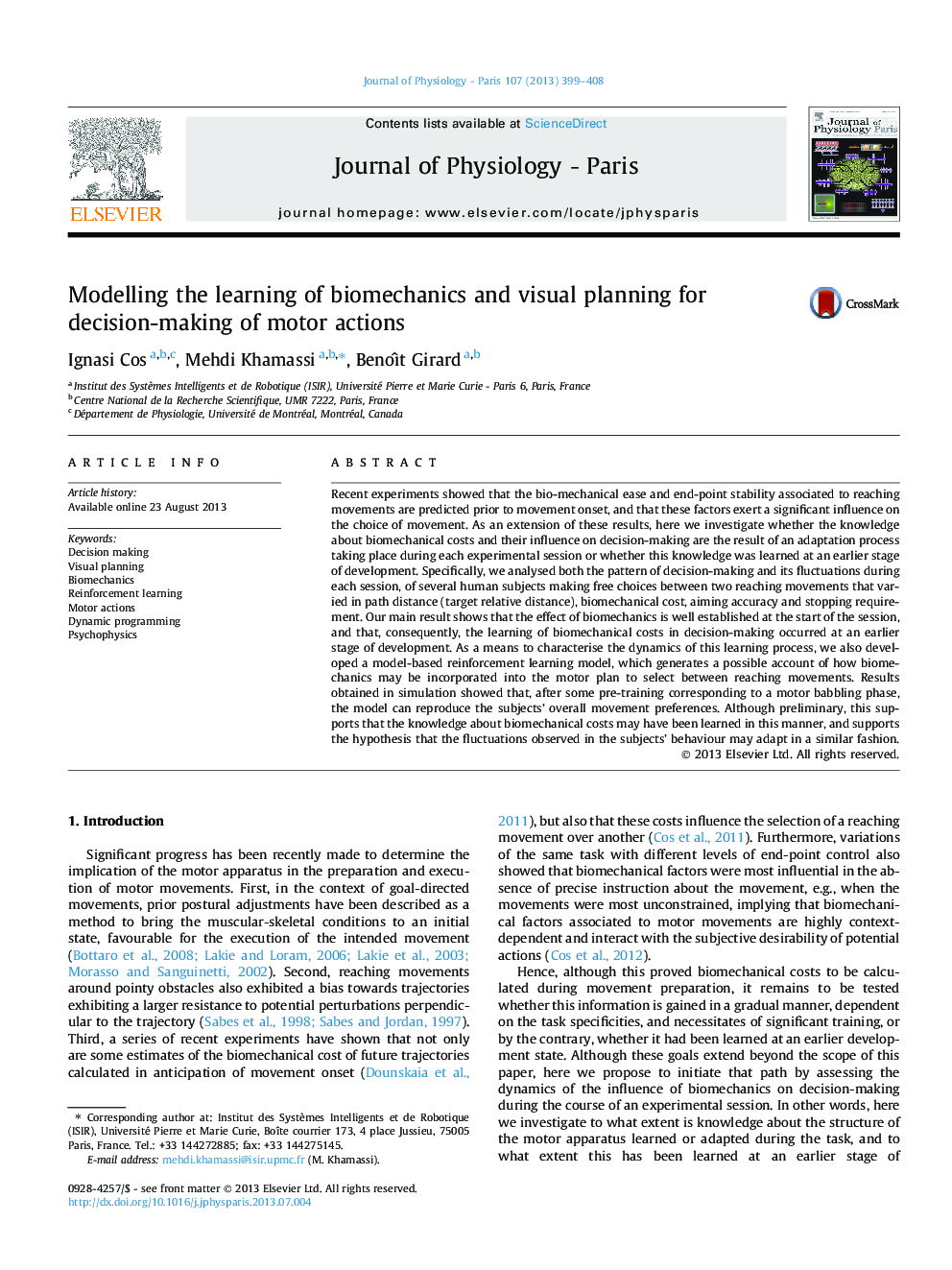| کد مقاله | کد نشریه | سال انتشار | مقاله انگلیسی | نسخه تمام متن |
|---|---|---|---|---|
| 5922366 | 1165974 | 2013 | 10 صفحه PDF | دانلود رایگان |
عنوان انگلیسی مقاله ISI
Modelling the learning of biomechanics and visual planning for decision-making of motor actions
ترجمه فارسی عنوان
مدل سازی یادگیری بیومکانیک و برنامه ریزی بصری برای تصمیم گیری حرکت های حرکتی
دانلود مقاله + سفارش ترجمه
دانلود مقاله ISI انگلیسی
رایگان برای ایرانیان
کلمات کلیدی
تصمیم سازی، برنامه ریزی بصری، بیومکانیک، تقویت یادگیری، اقدامات موتور، برنامه نویسی دینامیک، روانپزشکی،
ترجمه چکیده
آزمایش های اخیر نشان داده اند که سهولت بیوموکتیکی و پایایی نقطه پایانی مرتبط با رسیدن به حرکات قبل از شروع حرکت پیش بینی شده است و این عوامل تأثیر قابل توجهی بر انتخاب حرکت دارند. به عنوان یک فرمت از این نتایج، در اینجا بررسی می کنیم که آیا دانش در مورد هزینه های بیومکانیک و تاثیر آن در تصمیم گیری، نتیجه یک فرایند انطباق است که در طول هر جلسه تجربی اتفاق می افتد یا اینکه آیا این دانش در مرحله اولیه توسعه آموخته شده است. به طور خاص، ما هر دو الگوی تصمیم گیری و نوسانات آن را در طی هر جلسه بررسی کردیم، از چندین موضوع انسانی که انتخاب آزادانه بین دو جنبش که در فاصله مسیر (فاصله نسبی هدف)، هزینه های بیومکانیکی، دقت هدف و نیاز متوقف شده متفاوت بود. نتیجه اصلی ما نشان می دهد که اثر بیومکانیک در آغاز جلسه به خوبی مشخص شده است و در نتیجه، یادگیری هزینه های بیومکانیکی در تصمیم گیری ها در مرحله اولیه توسعه رخ داده است. به عنوان یک وسیله برای توصیف پویایی این فرایند یادگیری، ما همچنین یک مدل یادگیری تقویت یادگیری را ایجاد کردیم که یک امکان احتمالی را در مورد اینکه چگونه بیومکانیک ممکن است در طرح حرکتی برای گزینش بین حرکات رسیدن ایجاد شود، ایجاد می کند. نتایج حاصل از شبیه سازی نشان داد که پس از برخی از پیش آمادگی های مربوط به فاز بلبلی موتور، مدل می تواند ترجیحات جنبش عمومی افراد را بازتولید کند. اگر چه مقدماتی، این امر حاکی از آن است که دانش در مورد هزینه های بیومکانیک ممکن است به این طریق آموخته شود و از این فرضیه پشتیبانی می کند که نوسانات مشاهده شده در رفتار افراد ممکن است با روش مشابه هماهنگ شوند.
موضوعات مرتبط
علوم زیستی و بیوفناوری
بیوشیمی، ژنتیک و زیست شناسی مولکولی
فیزیولوژی
چکیده انگلیسی
Recent experiments showed that the bio-mechanical ease and end-point stability associated to reaching movements are predicted prior to movement onset, and that these factors exert a significant influence on the choice of movement. As an extension of these results, here we investigate whether the knowledge about biomechanical costs and their influence on decision-making are the result of an adaptation process taking place during each experimental session or whether this knowledge was learned at an earlier stage of development. Specifically, we analysed both the pattern of decision-making and its fluctuations during each session, of several human subjects making free choices between two reaching movements that varied in path distance (target relative distance), biomechanical cost, aiming accuracy and stopping requirement. Our main result shows that the effect of biomechanics is well established at the start of the session, and that, consequently, the learning of biomechanical costs in decision-making occurred at an earlier stage of development. As a means to characterise the dynamics of this learning process, we also developed a model-based reinforcement learning model, which generates a possible account of how biomechanics may be incorporated into the motor plan to select between reaching movements. Results obtained in simulation showed that, after some pre-training corresponding to a motor babbling phase, the model can reproduce the subjects' overall movement preferences. Although preliminary, this supports that the knowledge about biomechanical costs may have been learned in this manner, and supports the hypothesis that the fluctuations observed in the subjects' behaviour may adapt in a similar fashion.
ناشر
Database: Elsevier - ScienceDirect (ساینس دایرکت)
Journal: Journal of Physiology-Paris - Volume 107, Issue 5, November 2013, Pages 399-408
Journal: Journal of Physiology-Paris - Volume 107, Issue 5, November 2013, Pages 399-408
نویسندگان
Ignasi Cos, Mehdi Khamassi, BenoıËt Girard,
